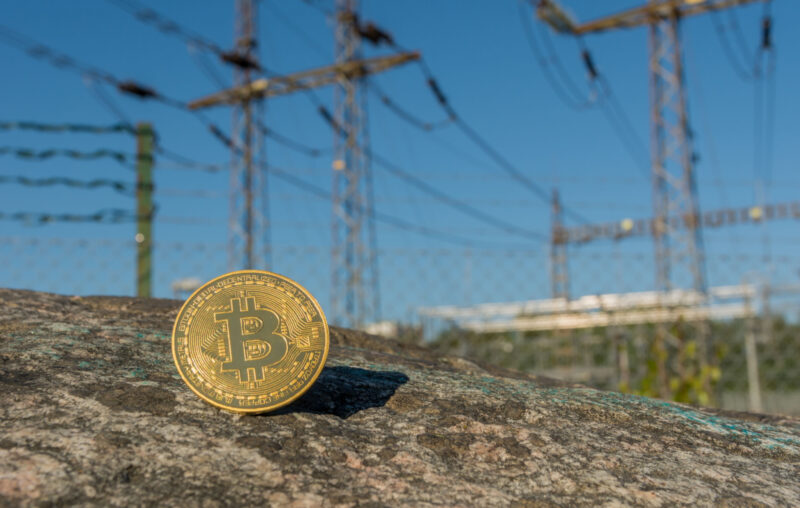Bitcoin Scoops Up Stranded and Excess Power

Electricity has the difficult quality of having to be consumed when it’s produced. Put differently: Since we expect the lights to turn on any time we flip a switch, electricity must be produced whenever consumers so desire.
For most of its 150-odd year history, electricity grids had good control over their supply — crank up the dials, burn more fuel, run more turbines — but had to forecast the demand, always anticipating and micromanaging ever so slight changes in usage. Today we have more and more renewable producers on the grid, which has turned the supply itself more unreliable depending not so much on human decisions as a capricious weather. Blanket the landscape with wind towers and PV parks that produce too much electricity at times we don’t need it and next to nothing when we really do, and we have a tragic recipe for unstable grids.
We still expect the grid to deliver, always, and so grid operators must make sure that plenty of extra capacity stands ready to meet peak demand regardless of weather patterns. It means that some turbines run without load engaged, and with plenty more ready to ramp up when the weather forecast suggests bad conditions.
Having all that extra capacity is expensive and wasteful — intentionally so. Result? They run inefficiently, the technical term being “overbuilt,” often by more than 50 percent, since we expect the grid to cover not only the average usage but the extreme peaks. Somebody must carry the financial cost of all that constructed capacity and fuel storage and, which, squeezed through local energy politics is reflected in the rates consumers pay. It’s too late to start raising wind farms, build gas plants, or plan transmission lines today if there’s peak electricity demand forecasted for the weekend.
When we add large portions of wind and solar to the grid, occasionally flooding the grid with so much abundant electricity that power prices turn negative, the sum total becomes more expensive electricity, not less, even though their inputs are delivered to us free of charge from nature.
What we need is an electricity user, a consumer-of-last-resort, that could scoop up any excess electricity, that could disengage at a moment’s notice and return the generation for the occasional shortfall or cold snap. One that could co-locate with the power plants and thus avoid extra transmission lines criss-crossing the landscape for its large-scale production purposes.
Bitcoin is an awesome monetary technology, revolutionizing the world of money and assets and savings one skeptic at a time. In its wake, we find all sorts of beneficial second-order effects — improving the electricity grid and vacuuming up stranded worldwide energy just being the latest one. “Bitcoin miners are the economically perfect consumers of electricity,” concludes Lee Bratcher for Bitcoin Magazine, “their consistent consumption incentivizes the buildout of additional generation.”
During the winter storm Finn in January, upward of a quarter of Bitcoin hashrate went offline, since a lot of global hashpower now resides in Texas and are involved in various load-shedding and demand-response programs with the grid operator ERCOT.
Before bitcoin, demand-response programs were neat little ideas that never seemed to work. As Meredith Angwin concludes in her book Shorting the Grid: “You can offer to pay customers to give up electricity on very cold days. However, very few will take your offer.” The reason that the grid is strained during a cold snap is the same reason power users place a very high value on their electricity use. The supply gets squeezed precisely at the time consumer demand becomes price inelastic, with heating and lighting homes becoming next to infinitely valuable in a pickle.
Says James McAvity of Cormint, a renewable-energy bitcoin miner in west Texas, “Base load that does not contribute to peaks is literally the ideal market participant in a power grid. This is especially true for grids with high renewable penetration.”
Hashing, the electricity-intensive cryptographic process that mining equipment run to find and confirm new Bitcoin blocks, is a competitive, random process of guessing nonces. That means turning on and shutting off miners won’t harm miners’ progress the way that such sudden switch-offs would in data centers or other large-scale users like energy-intensive manufacturing. An overbuilt grid with spare electricity generation can sell that surplus generation to bitcoin miners instead of curtailing overproduction or letting plants stand idle. Miners pay the plants for electricity that otherwise would have gone to waste. In severe conditions, like surging power usage or cold snaps like much of the US South experienced in January, miners can effortlessly turn off and return the electricity-generation capacity to the grid. When conditions normalize, the miner can pick up hashing at the front of Bitcoin’s blockchain, with nothing lost but the upkeep time — for which the demand-response programs directly reimburse them or which gets reflected in the price negotiated between miners and power plants.
Bitcoin miners derive their revenue from transaction fees and block confirmations on a global market, entirely uncorrelated with short-term, local electricity demands and weather patterns. Shutting off — in effect returning power to the grid when that power temporarily becomes more valuable for non-mining use elsewhere — is a simple and economically sound process. A win-win-win-win for grids, consumers, miners, and green energy advocates alike.
That extra revenue could also make power plant constructions financially viable, where overbuilt capacity no longer is a pure expense. With miners scattered across the grid, heavily incentivized to find the cheapest, stranded source of energy around.
With bitcoin mining supporting the grid, we could use installed capacity better, waste less resources, remove some of consumers’ requirement to shoulder overbuilt capex expenses that are only needed in extreme events. That consumer-of-last-resort could secure electricity grids and monetize their resilience.
Bitcoin mining, far from being unnecessary drivers of climate change, is the missing puzzle piece that stabilizes volatile green energy and makes electricity grids fit for the twenty-first century.










